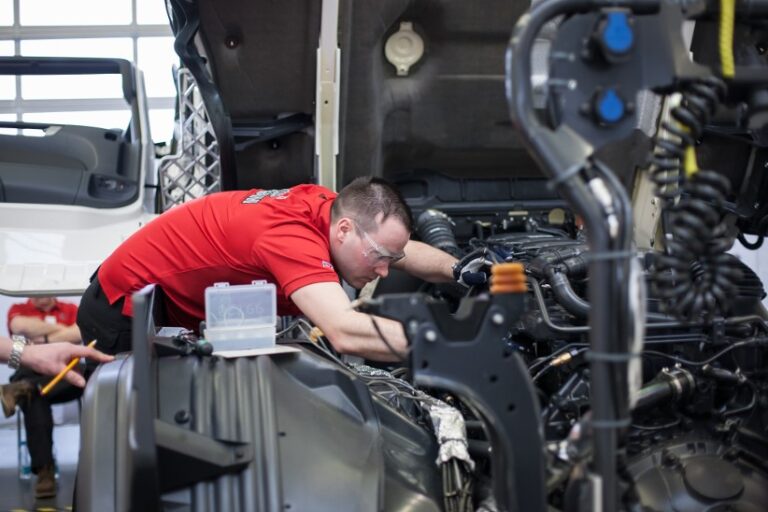Managing a fleet of heavy vehicles requires a robust maintenance management system to ensure vehicles remain in top condition, reducing the risk of breakdowns and ensuring compliance with safety regulations. The Maintenance Management System (MMS) under the National Heavy Vehicle Accreditation Scheme (NHVAS) provides a structured approach to managing vehicle maintenance. This guide breaks down the eight essential steps fleet managers should follow to implement and maintain this system effectively.
1. Daily Checks
Objective: Ensure every vehicle is safe before it hits the road.
Each day, before any vehicle is used, a basic safety check must be completed and documented. This check should cover critical components such as wheels, tyres, lights, windscreen, mirrors, and brakes. The person performing the check must certify the vehicle’s safety. It’s crucial to keep a record of these daily checks as part of your maintenance documentation. This step ensures that minor issues are caught early, preventing them from becoming major, costly repairs.
Action Points:
- Develop a checklist for daily inspections.
- Assign responsible personnel for daily checks.
- Ensure documentation of each check is thorough and accessible.
2. Fault Recording and Reporting
Objective: Maintain an accurate record of all vehicle faults.
During operation, drivers may encounter faults that could impact vehicle safety or performance. A system must be in place for drivers to record these faults immediately and report them for assessment. These records should be retained with the vehicle until the fault is rectified. This step is vital in ensuring that faults are addressed promptly, preventing further damage or safety hazards.
Action Points:
- Implement a fault recording logbook or digital system.
- Train drivers on fault reporting procedures.
- Establish a clear process for communicating faults to maintenance teams.
3. Fault Repair
Objective: Prioritise and repair faults efficiently.
Once a fault is reported, it must be assessed, and a priority level should be assigned for its repair. This includes deciding whether the fault can be monitored, deferred, or needs immediate attention. The decision-maker must be recorded, and all repairs must be documented, including testing after repair. This ensures that all faults are tracked from discovery to resolution, maintaining vehicle safety and reliability.
Action Points:
- Create a fault assessment and prioritization process.
- Keep detailed records of all repairs and their outcomes.
- Assign responsibility for fault repair decisions to qualified personnel.
4. Maintenance Schedules and Methods
Objective: Establish regular maintenance routines.
Your MMS should include a maintenance schedule that outlines when and what maintenance tasks need to be performed. These schedules should be based on the vehicle’s usage, either in terms of time, distance, or hours of operation. The schedule must also comply with the manufacturer’s specifications and the National Roadworthiness Guidelines. Regular maintenance helps extend the life of your vehicles and ensures they are always roadworthy.
Action Points:
- Develop and adhere to a maintenance schedule.
- Include detailed tasks for each maintenance period.
- Ensure maintenance personnel are aware of and follow these schedules.
5. Records and Documentation
Objective: Maintain comprehensive records for all maintenance activities.
Accurate documentation is the backbone of your MMS. This includes keeping a register of all vehicles, maintenance records, fault reports, and repair logs. These records demonstrate that your fleet complies with maintenance standards and can be reviewed during audits. Proper documentation also facilitates efficient management and quick access to vehicle histories.
Action Points:
- Keep a detailed register of all vehicles in the fleet.
- Maintain records of all inspections, faults, repairs, and maintenance activities.
- Ensure records are updated regularly and stored securely.
6. Responsibilities
Objective: Clearly define roles within the maintenance management system.
Each task within the MMS must be assigned to a specific person or role. This ensures that all aspects of the system are managed effectively, with clear accountability. Everyone involved in the maintenance process should know their responsibilities and how they fit into the overall system. This clarity helps prevent tasks from being overlooked and ensures a cohesive approach to vehicle maintenance.
Action Points:
- Assign specific responsibilities for each task in the MMS.
- Document these responsibilities in your MMS manual.
- Communicate these responsibilities to all relevant staff.
7. Internal Review
Objective: Regularly review and improve the maintenance management system.
Conducting internal reviews on a quarterly and annual basis ensures that your MMS is functioning correctly and meeting its objectives. These reviews should identify any non-compliances or areas for improvement, allowing you to make necessary adjustments before external audits. Regular internal reviews help maintain the integrity of the system and ensure continuous improvement.
Action Points:
- Schedule regular internal reviews.
- Assign independent personnel to conduct reviews.
- Document findings and implement corrective actions.
8. Training and Education
Objective: Ensure all personnel are trained in the maintenance management system.
Training is essential for all staff involved in the MMS, from drivers to maintenance technicians and managers. Everyone must understand the system, their role within it, and the procedures they need to follow. Continuous education ensures that your team stays updated on best practices and any changes to the system or regulations.
Action Points:
- Develop a training program for all staff involved in the MMS.
- Keep records of all training sessions, including participants and content.
- Update training materials regularly to reflect any changes in the system.
Conclusion
Implementing and maintaining a robust Maintenance Management System is critical for fleet managers overseeing trucks. By following these eight steps, you can ensure your vehicles are well-maintained, compliant with safety regulations, and less likely to suffer costly breakdowns. A well-managed MMS not only protects your fleet but also enhances efficiency and reliability, ultimately contributing to the success of your business.






